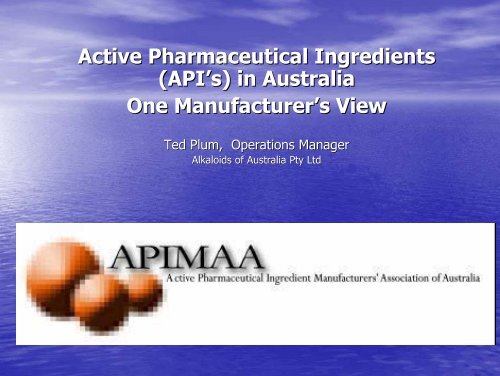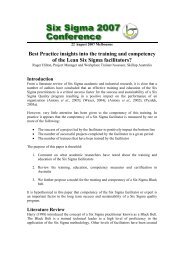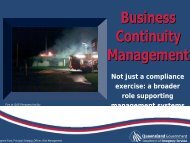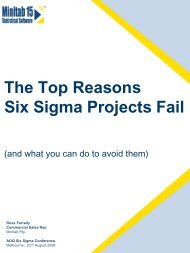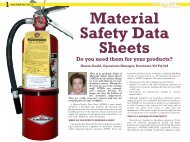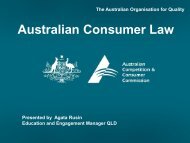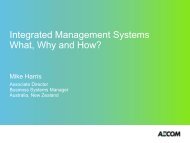Active Pharmaceutical Ingredients - Australian Organisation for Quality
Active Pharmaceutical Ingredients - Australian Organisation for Quality
Active Pharmaceutical Ingredients - Australian Organisation for Quality
Create successful ePaper yourself
Turn your PDF publications into a flip-book with our unique Google optimized e-Paper software.
<strong>Active</strong> <strong>Pharmaceutical</strong> <strong>Ingredients</strong><br />
(API’s) in Australia<br />
One Manufacturer’s s View<br />
Ted Plum, Operations Manager<br />
Alkaloids of Australia Pty Ltd
Acknowledgement<br />
This presentation was initially<br />
developed by Tim Bowser,<br />
Operations Manager, Glaxo SmithKline<br />
<strong>for</strong> the <strong>Active</strong> <strong>Pharmaceutical</strong> Ingredient<br />
Manufacturers Association of Australia<br />
APIMAA
Overview<br />
• Introduction to the API Manufacturers Industry<br />
Representative Body-APIMAA<br />
• APIMAA background & objectives<br />
• Our TGA experience<br />
• API manufacture in Australia<br />
• API manufacture in Australia - Special<br />
Challenges<br />
• API manufacture – GMP in the 21st Century<br />
• Future Activities<br />
• A View of one Manufacturer
APIMAA<br />
• Peak industry body representing <strong>Active</strong><br />
<strong>Pharmaceutical</strong> Ingredient manufacturers<br />
in Australia<br />
• APIMAA membership represent >80% of<br />
API value manufactured in Australia<br />
• Employ over 400 staff, exports total in<br />
excess of A$250m, dominant world<br />
players in Natural Product Extraction &<br />
Alkaloid API production
APIMAA<br />
• APIMAA was <strong>for</strong>med when the main API<br />
manufacturers joined <strong>for</strong>ces in 1997 in<br />
response to TGA introducing the API code<br />
of GMP (1996-2001, ICH Q7A )<br />
• APIMAA was invited by TGA to be involved<br />
in the policy development, and played a<br />
key role in the review of ICH Q7A.
APIMAA Objectives<br />
• Represent the interests of API<br />
manufacturers in Australia<br />
• Regular communication with the TGA<br />
• Raise the profile of the <strong>Australian</strong> API<br />
industry<br />
• Technical skills support network <strong>for</strong><br />
members
• Consultation<br />
Our TGA Experience<br />
– Our own code of Good Manufacturing Practice<br />
(cGMP) – Q7A<br />
– Regularly meet with TGA executive<br />
– APIMAA provides open <strong>for</strong>um <strong>for</strong> common<br />
concerns of members<br />
– Advice obtained on specialist issues<br />
– Association provides point of contact <strong>for</strong><br />
consultation on regulatory policy change
• Audits<br />
Our TGA Experience<br />
– All members audited in past 2 - 4 years<br />
– Observed increase in Audit consistency<br />
– Man-hours per audit quadrupled<br />
– Main observations – environmental control,<br />
validation and risk management
API Manufacture in Australia<br />
• Definition of an API according to the cGMP<br />
• API Manufacture presents unique GMP<br />
challenges
API Manufacture in Australia<br />
• A limited number of manufacturers operate in<br />
Australia:-<br />
• Alkaloids of Australia<br />
Hyoscine (Scopolamine) derivatives<br />
• Glaxo SmithKline<br />
Codeine and Morphine<br />
• Phytex Australia<br />
Hyoscine and Castanospermine<br />
derivatives<br />
• Tasmanian Alkaloids<br />
Morphine, Thebaine
API Manufacture in Australia
API Manufacture in Australia
API Manufacture in Australia<br />
• API’s s manufactured:<br />
alkaloids, flavenoids, , extraction of<br />
bioactives, , biopharmaceuticals, etc<br />
• API’s s are used <strong>for</strong> finished product<br />
manufacture, drug development and<br />
clinical trials<br />
• Significant R&D product development<br />
programs <strong>for</strong> new API’s
API Manufacture in Australia
API Manufacture in Australia
API Manufacture in Australia
API Manufacture in Australia
API Manufacture in Australia<br />
Special Challenges<br />
• The (not) Level Playing Field<br />
– Formulators importing from non-regulated API<br />
suppliers<br />
– High level of productivity required to compete<br />
internationally<br />
– TGA GMP expectations - “highly regulated<br />
environment”<br />
• The offshore competition’s s size and<br />
globalisation
API Manufacture in Australia<br />
Special Challenges<br />
• Limited support network <strong>for</strong> Technical<br />
skills<br />
– Small number of API manufacturers<br />
– Facilities often located in regional areas<br />
– Limited pool of technical staff that understand<br />
API manufacture and have GMP experience<br />
– No equivalent Fine Chemicals Industry
API Manufacture in Australia<br />
Special Challenges<br />
• Hazardous Chemicals<br />
– Natural Product Extraction & API manufacture<br />
– Hazardous area regulations<br />
– Safe manufacture requires specialist technical<br />
skills<br />
– GMP requirements – residual solvents
API Manufacture in Australia<br />
Special Challenges<br />
• Natural Product Complexities<br />
– Natural Products variable by their nature<br />
– Special requirements<br />
• eg. pesticides, herbicides <strong>for</strong> plant materials<br />
– Process understanding requires advanced<br />
chemistry & engineering know-how<br />
– Robust manufacturing processes required to<br />
produce consistent quality<br />
– Contamination control / sterility <strong>for</strong> tissue<br />
derived materials
API Manufacture in Australia<br />
Special Challenges<br />
• Biotechnology Product Complexities<br />
– Closed system, “sterile” manufacturing<br />
process<br />
– Some process equipment can not be<br />
sterilised, requires sanitisation<br />
– Inherent API heterogeneity & highly complex<br />
analytical methods<br />
– Manufacturing process is integral part of<br />
product quality definition
API Manufacture<br />
Dealing with GMP in the 21st Century<br />
• Increased Scientific Understanding<br />
– Greater understanding of <strong>Quality</strong> Critical<br />
Parameters<br />
– Emphasis on Processes Understood, Capable<br />
& Controlled<br />
– Increased use of Statistical methodology<br />
• Validation<br />
– proof of process control capability
API Manufacture<br />
Dealing with GMP in the 21st Century<br />
• Particulate Contamination<br />
– Environmental Control of Product Isolation<br />
• Systematic approach to Risk Management<br />
– ICH Q9 - Risk in small enterprises<br />
• <strong>Quality</strong> Management Systems<br />
– ICH Q10 and ISO 13485<br />
– why is ISO 9000 not enough <strong>for</strong> regulators!
• Qualified Person<br />
Future Activities<br />
– Industry input into developing a certification<br />
model <strong>for</strong> the ‘Qualified Person’ welcomed<br />
– Should enhance International image of<br />
<strong>Australian</strong> API manufacturers<br />
• Level Playing Field<br />
– Tighter GMP control of API importers<br />
welcomed
•A A VIEW OF ONE<br />
API MANUFACTURER
Alkaloids of Australia<br />
• Operations are based on synthesis of<br />
Scopolamine (Hyoscine) derivatives from<br />
extracts of the Duboisia plant<br />
• A locally owned, the sole <strong>Australian</strong><br />
Hyoscine API manufacturer located in<br />
Kingaroy<br />
• Vertically integrated company selling<br />
commodity API’s s almost entirely to export<br />
• A small but significant and competitive<br />
part of the world market
Alkaloids of Australia<br />
• Scopolamines are tropane alkaloids, a<br />
quaternary ammonium compound the common<br />
<strong>for</strong>ms of which are the butyl and hydro<br />
bromides.<br />
• They are muscarinic antagonists (CNS<br />
interferers)<br />
• Used in<br />
- Travel sickness tablets<br />
- Pre and post operative injectables<br />
- General analgesics – particularly overseas<br />
- Ophthalmic solutions (pupil dilation)
Alkaloids of Australia<br />
• Commercial Duboisia plants are hybrids of<br />
a cross developed in the late 60’s s from 2<br />
<strong>Australian</strong> natives<br />
• Almost all the world’s s commercial<br />
scopolamine is grown around Kingaroy
Alkaloids of Australia<br />
• Leaf contains from 1 – 3% scopolamine<br />
along with other related compounds<br />
• Harvested, stripped and dried October to<br />
May and stored <strong>for</strong> processing
Alkaloids of Australia<br />
• Unique extraction process yields the<br />
scopolamine base
Alkaloids of Australia<br />
Synthesis and purification of the hydro and<br />
butyl bromides follows
Alkaloids of Australia<br />
• Preparation of the dried product <strong>for</strong><br />
packaging to 1 kg containers
Alkaloids of Australia<br />
• Dispatch to order in quantities of 1 – 1000<br />
kg
Thank you <strong>for</strong> this opportunity to share our<br />
view of the smallest part of Australia’s<br />
pharmaceutical industry


